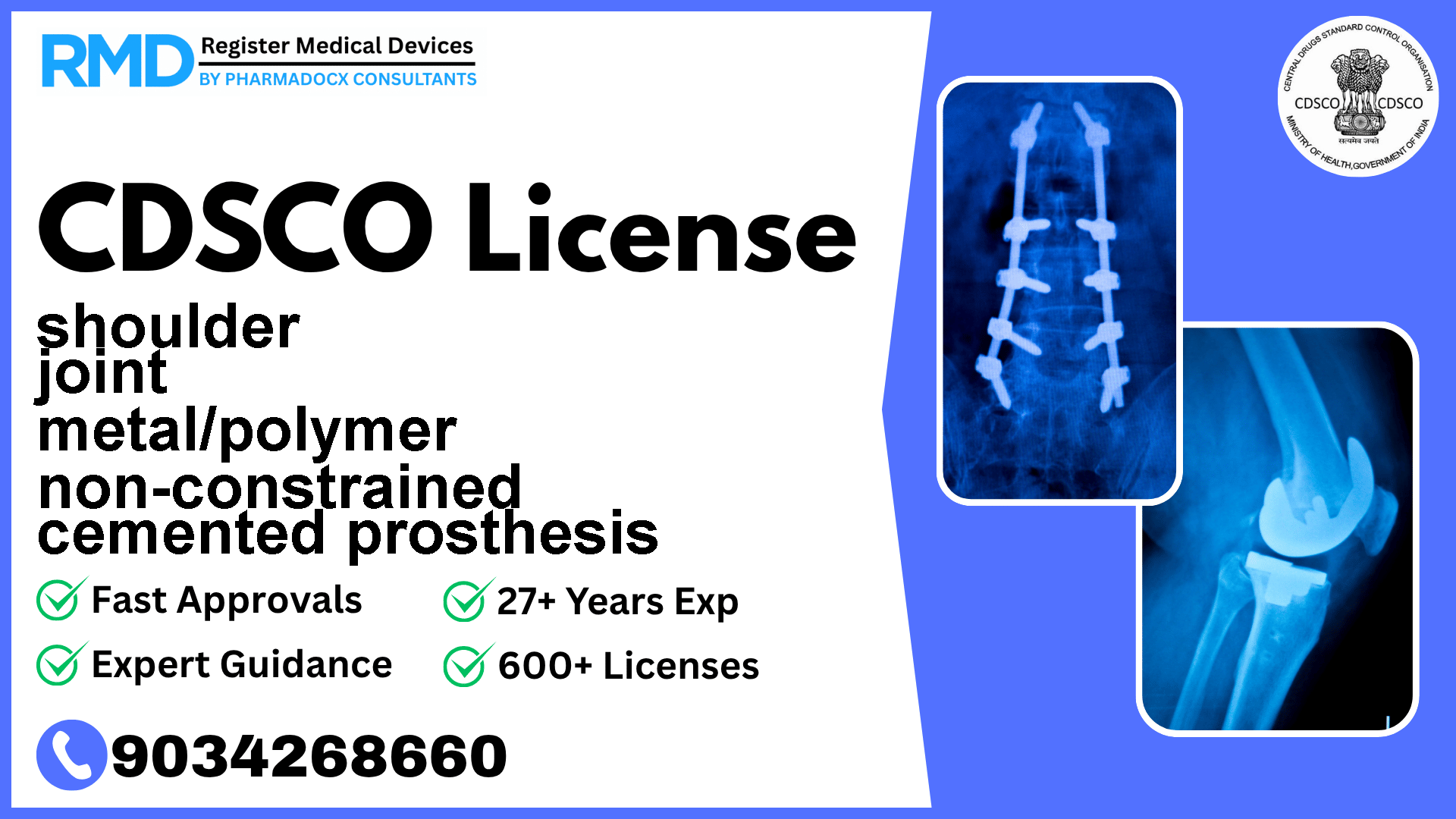CDSCO License for shoulder joint metal/polymer non-constrained cemented prosthesis
Medical Device Information
Intended Use
Intended to be implanted to replace a shoulder joint

Comprehensive Guide to CDSCO Licensing for Shoulder Joint Metal/Polymer Non-Constrained Cemented Prosthesis (Class C Orthopaedic Implant)
Navigating the regulatory landscape for high-risk medical devices like the shoulder joint metal/polymer non-constrained cemented prosthesis can be complex. As experienced regulatory consultants with over 25 years of expertise and having assisted over 500 companies, we provide you with a detailed pathway to secure your CDSCO license smoothly and efficiently.
Understanding the Device and Its Regulatory Importance
The shoulder joint metal/polymer non-constrained cemented prosthesis is a Class C orthopaedic implant device, intended for implantation to replace a shoulder joint. Given its invasive nature and critical function, it falls under a higher risk classification, necessitating stringent regulatory oversight to ensure safety and efficacy. The device is notified under CDSCO Notification 29/Misc/3/2017-DC (292) dated 06.06.2018, making compliance mandatory before marketing or manufacturing in India.
CDSCO Regulatory Framework for Class C Orthopaedic Implants
Under the Medical Device Rules, 2017, Class C devices like this prosthesis require licensing from the Central Licensing Authority via the MD9 license (application Form MD7). The process involves multiple steps, including obtaining a Test License, product testing at CDSCO-approved laboratories, document preparation, and an on-site audit.
Risk Classification and License Requirements
- Device Risk Class: C (High risk)
- License Type: MD9 Manufacturing License
- Authority: Central Licensing Authority, CDSCO
- Application Form: MD7
- Applicable Standards: ISO 13485:2016 for QMS, Essential Principles checklist, and Risk Management per ISO 14971
For more details on device classification, refer to our Medical Device Classification guide.
Step-by-Step Manufacturing License Process (MD9)
- Test License Application (Form MD13): Before the manufacturing license, obtain a test license valid for 3 months. Processing takes about 1.5 to 2 months.
- Product Testing: Submit the prosthesis samples to CDSCO-recognized labs. A comprehensive list is available on the Testing Laboratories portal.
- Documentation Preparation: Prepare all requisite documents including Device Master File, Plant Master File, and Risk Management File.
- Submit Manufacturing License Application (Form MD7): Apply through the CDSCO MD Online Portal.
- Audit by CDSCO Inspectors: CDSCO will perform a thorough audit of your manufacturing facility and quality systems.
- Query Resolution: Address queries raised during audit or document review promptly.
- Grant of License (Form MD9): Upon satisfactory compliance, license is granted.
This entire process typically spans 4 to 5 months.
Essential Documents Required for MD9 License Application
- Company Constitution Documents (e.g., MOA, AOA)
- Proof of Ownership or Lease of Manufacturing Premises
- Qualification and Experience Certificates of Technical Staff
- Fire Safety NOC
- Pollution Control Board NOC
- Device Master File (DMF) – detailed design, manufacturing process, and safety data. Learn more from our Device Master File Guide.
- Plant Master File (PMF) – facility layout, equipment details, and quality control processes. Our Plant Master File Guide offers practical tips.
- Essential Principles Compliance Checklist
- Risk Management File aligned with ISO 14971 standards (Risk Management Guide)
- Product Test Reports from CDSCO-approved labs
- Product Labels and Instructions for Use (IFU)
- Quality Management System Documents (ISO 13485:2016)
Import License Process (MD15) for Shoulder Joint Prosthesis
If importing the prosthesis, you need an MD15 import license from the Central Licensing Authority. The process differs slightly:
- No Test License Required
- Submit application via Form MD14 on CDSCO MD Online Portal
- Provide Manufacturing License from the country of origin, Free Sale Certificate, ISO 13485:2016, CE Certificate, Device Master File, Plant Master File, Wholesale License, and Company Constitution
- Estimated timeline: 5–6 months
- Government fees vary by risk class; for Class C devices, expect around INR 2,40,000 (approx 1500 per product)
Refer to our detailed Import License Guide for application nuances.
Timeline and Processing Duration
| Step | Duration |
|---|---|
| Test License (MD13) | 1.5 - 2 months |
| Product Testing | 3 - 4 weeks |
| Document Preparation | 3 - 4 weeks |
| Application Review & Audit | 1.5 - 2 months |
| Total Estimated Time | 4 - 5 months |
Government Fees and Costs
- MD9 Manufacturing License Fee: INR 50,000 per application
- Per Product Fee: INR 1,000 per product
- Testing Fee: Variable depending on number of tests and laboratories
Budgeting for these fees upfront helps avoid delays.
Common Challenges and Practical Solutions
- Delayed Test Reports: Plan sample submission early and choose labs with shorter turnaround times from the CDSCO Testing Labs list.
- Incomplete Documentation: Use a checklist to ensure all documents, including Device and Plant Master Files, are comprehensive.
- Audit Non-Compliance: Conduct internal mock audits before CDSCO inspection to identify gaps.
- Query Management: Respond to CDSCO queries within stipulated timelines with precise, evidence-backed answers to avoid processing delays.
Expert Consultation and Support
With decades of hands-on experience, our regulatory experts assist manufacturers and importers through every step — from documentation to audit preparation. We have helped over 500 companies launch their orthopaedic implants in India with compliant CDSCO licenses. Our client-focused approach ensures your application is robust and audit-ready.
Getting Started with Your CDSCO MD9 License Application
- Assess Your Current Compliance: Review your QMS, technical files, and facility readiness.
- Engage a CDSCO-Recognized Testing Laboratory: Early product testing is critical.
- Compile Essential Documents: Leverage our Device Master File and Plant Master File guides.
- Submit Test License Application (MD13) via the CDSCO MD Online Portal.
- Prepare for Audit: Schedule internal audits and training.
- Apply for MD9 License: Once test license and testing are complete.
Embarking on this process with expert support significantly reduces risk and expedites your market entry. Contact us today to start your CDSCO licensing journey for your shoulder joint metal/polymer non-constrained cemented prosthesis.